Boundary Falls Limestone
*Glass making
*Ingredient in toothpaste
*Bread and cereals as a *source of calcium
*Making paper white
*Sugar purification
*Making brake pads
*Preparation of wools and dyes
*Climbing walls
*A suppression of methane *explosions in underground coalmines
*Manufacturing of quicklime (calcium oxide) and slaked lime (calcium hydroxide).
*Manufacturing of steel
*Lower water pH
*Food preservation
The earliest mining operations in the Boundary District took place during the year 1862. The first lode claim was staked in 1884 near Boundary Falls. By 1895 there were 370 claims on record at the Midway recording office. In 1895 770 new claims were made and in 1896 over 1200 more claims were recorded. This sudden rush was due to an influx of prospectors from Trail Creek and Colville.
Boundary Falls Limestone was located northeast of the ghost town of Boundary Falls. The deposit is comprised of white and bluish grey streaked, medium grained limestone. Although there is nothing left, we did find evidence of two kilns, and the side of the mountain where they mined the limestone. Through our search we could not find any production figures for this mine, which operated in the early 1900’s.
A little further northeast of where Boundary Limestone was located we came across two more kilns. These two were a little more intact. Although caved in, they were quite large.
Limestone is a sedimentary rock consisting primarily of calcium carbonate, sometimes a considerable amount of magnesium carbonate in the form of dolomite. Limestone can come in many colours but is usually white, grey or black.
The early limestone kilns, pictured here, were mainly used in the making of mortar, bricks, and cement for building material.
Limestone has many uses, which include patio blocks, landscaping rock, concrete aggregate and soil conditioner. Limestone is also used as an additive to paint and other products, and a source of calcium carbonate which is used in a great deal of products including antacids. Cooked limestone is used to make Portland cement, the key ingredient in mortars, cements, and concrete.
Boundary Falls Limestone was located northeast of the ghost town of Boundary Falls. The deposit is comprised of white and bluish grey streaked, medium grained limestone. Although there is nothing left, we did find evidence of two kilns, and the side of the mountain where they mined the limestone. Through our search we could not find any production figures for this mine, which operated in the early 1900’s.
A little further northeast of where Boundary Limestone was located we came across two more kilns. These two were a little more intact. Although caved in, they were quite large.
Limestone is a sedimentary rock consisting primarily of calcium carbonate, sometimes a considerable amount of magnesium carbonate in the form of dolomite. Limestone can come in many colours but is usually white, grey or black.
The early limestone kilns, pictured here, were mainly used in the making of mortar, bricks, and cement for building material.
Limestone has many uses, which include patio blocks, landscaping rock, concrete aggregate and soil conditioner. Limestone is also used as an additive to paint and other products, and a source of calcium carbonate which is used in a great deal of products including antacids. Cooked limestone is used to make Portland cement, the key ingredient in mortars, cements, and concrete.
More Uses for Limestone:
View from the Boundary Falls Limestone Mine The Crowsnest Highway
View from the Limestone Mine/Anaconda Smelter
Limestone Mine
We found two more kilns not far from Boundary Falls Limestone
Check this video on Boundary Falls Limestone
Midway BC
Columbia & Western Railroad (CPR)
Midway BC
During the early 1800’s the U.S. claimed this area and all of B.C. north to 54 degrees until the treaty of 1846, which set the border at the 49 parallel.
When gold was discovered at Rock Creek in 1859, thousands of miners from the US came to this region. Governor Douglas hired Edgar Dewdney to make an east-west road. Dewdney cut a four-foot wide road from Hope to Rock Creek in 1860. In 1865 Dewdney again built a trail from Rock Creek through Midway and on to Ft. Steele. In 1869 Louis Eholt owned a ranch on what is now the town site of Midway. By 1889 Eholt’s place became a regular stopping place for prospectors travelling the Dewdney Trail. So he built a few cabins to store supplies and places for the miners to sleep. The little settlement was called “Eholts”. In 1892 Louis Eholt sold his property to R.C. Adams and Associates. Adams subdivided and offered lots for sale and called it “Boundary City”. Boundary City was situated halfway between the coast and the Rockies and also midway between Fort Hope and Fort Steele. In 1894 Ida McDonald opened the Boundary Creek School and the settlement adopted its present name. By June of 1901 Midway had 5 hotels, a meat market, dry goods store, bakery, pharmacy, sawmill, stationary shop, a wagon and carriage builder, and a stagecoach company. On May 25, 1967 Midway was incorporated as a Village. Heritage buildings include the Boundary Creek School, now a private residence, the original Police barracks dating to 1900 is now the Seniors’ Centre, and the Great Northern crew built the present Boundary Community Church in 1905.
When gold was discovered at Rock Creek in 1859, thousands of miners from the US came to this region. Governor Douglas hired Edgar Dewdney to make an east-west road. Dewdney cut a four-foot wide road from Hope to Rock Creek in 1860. In 1865 Dewdney again built a trail from Rock Creek through Midway and on to Ft. Steele. In 1869 Louis Eholt owned a ranch on what is now the town site of Midway. By 1889 Eholt’s place became a regular stopping place for prospectors travelling the Dewdney Trail. So he built a few cabins to store supplies and places for the miners to sleep. The little settlement was called “Eholts”. In 1892 Louis Eholt sold his property to R.C. Adams and Associates. Adams subdivided and offered lots for sale and called it “Boundary City”. Boundary City was situated halfway between the coast and the Rockies and also midway between Fort Hope and Fort Steele. In 1894 Ida McDonald opened the Boundary Creek School and the settlement adopted its present name. By June of 1901 Midway had 5 hotels, a meat market, dry goods store, bakery, pharmacy, sawmill, stationary shop, a wagon and carriage builder, and a stagecoach company. On May 25, 1967 Midway was incorporated as a Village. Heritage buildings include the Boundary Creek School, now a private residence, the original Police barracks dating to 1900 is now the Seniors’ Centre, and the Great Northern crew built the present Boundary Community Church in 1905.
Midway Hotel
Old school house
Entwined Trees
The Railroad War
In July of 1905, Hill won permission from the Canadian government to build a railroad across the Boundary westward to open up Southern BC and northern Washington state. His route was to go from Midway to Molson, Washington, and on to the coast.
In September of 1905, Jim Hill’s Vancouver, Victoria and Eastern Railroad (VV&E), Great Northern Railroad in the US (GNR) steamed up from across the border from Ferry, Washington to Midway, BC.
Since Midway was the end of the line for the CPR they were not planning to go further west at this time, so they decided to block the VV&E’s further advance. The CPR had a free hand in selecting blocks of property, and the VV&E were laying their tracks on one of the blocks the CPR selected. This block of land was nowhere near their tracks. CPR construction workers placed a fence made of logs (complete with no trespassing signs) across the VV&E’s already constructed grade just west of Midway near Hooligan’s Siding (named for the “Battle of Midway”), near the disputed area to house their workers in boarding cars.
VV&E workers then pulled down the fence. When VV&E workers arrived next morning they found that the fence was reconstructed and about 50 CPR workers were guarding the property. J.H. Kennedy, Chief Engineer of VV&E, then sent his workers to work further up the line. When Hill received the news he then filed a request for the CPR to sell him the property. Knowing what the answer would be Hill immediately filed an expropriation notice. Mr. Hill also bought some property near Princeton along the CPR's survey line just to retaliate. It took Hill over a month to secure his expropriation order, and on November 4th he had the right of way to the disputed property. The CP claimed the order was issued for a different piece of property and they refused to vacate the property. On November 7th more than one hundred VV&E workers arrived and gave the CP workers one minute to vacate the property. Outnumbered, the CP workers went back to Midway, and in minutes the telegraph was clicking, requesting every available CP worker in the area to report to Midway. In the meantime VV&E was building their own army. The small Midway police department could not do anything to stop hundreds of men pouring into the Midway area ready for battle. Over 300 CP construction workers were heading towards a tiny piece of property now guarded by the VV&E.
It was on this day on November 9, 1905, when the CP workers started ripping up the light tramway tracks, (used to haul rock while building tunnel #2), then twisted the tracks around the nearby trees. They also threatened to do the same to any VV&E worker who interfered. The VV&E workers stepped in and that’s when the crap hit the fan. Most of the men were equipped with axes, shovels, picks or whatever they could find. Since the CP workers outnumbered the VV&E workers, some shots were fired into the air by the VV&E workers to try and scare the CP workers off. Later in the evening the fighting cooled down as all the workers had realized that they were all railroad workers and their enemy was there for the same reason they were. That evening more than five hundred men set up camp on either side of the disputed property, settling in for the night so they could continue the battle in the morning. Before the night was over the Midway police decided to arrest CPR’s construction foreman and their land agent. The police thought they were responsible for the attacks. When the workers found out that no VV&E workers were arrested the CP workers became riled. Every time the police came around the VV&E workers would flee south a few hundred feet from their camp to the American side. Later that same night the police released the two men, hoping there would be no more trouble.
That same night VV&E workers received a boxcar load of barbwire and other reinforcements. By morning the VV&E workers laid out the barbwire along the right-of-way. They also laid heavy timbers across the remainder of the track, and in some places they bolted the tracks to the side of the mountain with heavy anchors. With the break of dawn the CP workers headed towards VV&E’s right-of-way for more destruction, only to find rows of barbwire. After seeing all this CPR workers decided to head for the saloons in Midway while waiting for barbwire cutters to arrive. Only to find that the Midway police closed all the saloons in Midway. Well they simply marched across the border to Ferry, Washington. The saloon in Ferry was already filled with VV&E workers, but that didn’t stop the CPR workers. They walked in sat down and drank together with their enemies.
Well you would think that this is the end of the silliness, but no there is one more. Three VV&E workers walked back to Midway and kidnapped the CPR land agent McLaine. When VV&E’s chief engineer found out he freed McLaine and made the men apologize. The three kidnappers charged McLaine for the attacks; in turn McLaine charged the kidnappers for kidnapping. Police held all four in jail till the next morning when all charges were dropped.
At this time each railway had about 150 men near the site, which each received $5.00 per day just to be there in case of more trouble. In all the fighting no one got killed, just bruises and broken bones. The dispute went before the courts, and it was later learned that the VV&E expropriation papers did indeed relate to a different piece of property and the CPR was granted an injunction prohibiting the VV&E from any work on the property. In turn the CPR sued the GNR for trespassing. Hill then appealed the injunction and was then granted a new expropriation paper to continue his building of the VV&E.
This little rendezvous put the little town of Midway on the world map. A Toronto paper expressed dismay that such a disgraceful thing could happen in such modern times. Writers from London, England expressed sadness that such a barbaric incident could occur in the British Empire. This doesn’t say much for what’s happening today (2013).
At the same time as all of this was going on, the CPR had right-of-way issues with Midway & Vernon Railway. The original promoters of M&V were James Kerr and Robert Wood of Greenwood. M&V started construction from Midway and had a line cleared to Rock Creek when the CPR thought that M&V was to cross their line. The CPR later learned that M&V had already purchased that property. Eventually the CPR purchased the charter of the Midway & Vernon Railway, and in the future it would be the Kettle Valley Railway (KVR)
In September of 1905, Jim Hill’s Vancouver, Victoria and Eastern Railroad (VV&E), Great Northern Railroad in the US (GNR) steamed up from across the border from Ferry, Washington to Midway, BC.
Since Midway was the end of the line for the CPR they were not planning to go further west at this time, so they decided to block the VV&E’s further advance. The CPR had a free hand in selecting blocks of property, and the VV&E were laying their tracks on one of the blocks the CPR selected. This block of land was nowhere near their tracks. CPR construction workers placed a fence made of logs (complete with no trespassing signs) across the VV&E’s already constructed grade just west of Midway near Hooligan’s Siding (named for the “Battle of Midway”), near the disputed area to house their workers in boarding cars.
VV&E workers then pulled down the fence. When VV&E workers arrived next morning they found that the fence was reconstructed and about 50 CPR workers were guarding the property. J.H. Kennedy, Chief Engineer of VV&E, then sent his workers to work further up the line. When Hill received the news he then filed a request for the CPR to sell him the property. Knowing what the answer would be Hill immediately filed an expropriation notice. Mr. Hill also bought some property near Princeton along the CPR's survey line just to retaliate. It took Hill over a month to secure his expropriation order, and on November 4th he had the right of way to the disputed property. The CP claimed the order was issued for a different piece of property and they refused to vacate the property. On November 7th more than one hundred VV&E workers arrived and gave the CP workers one minute to vacate the property. Outnumbered, the CP workers went back to Midway, and in minutes the telegraph was clicking, requesting every available CP worker in the area to report to Midway. In the meantime VV&E was building their own army. The small Midway police department could not do anything to stop hundreds of men pouring into the Midway area ready for battle. Over 300 CP construction workers were heading towards a tiny piece of property now guarded by the VV&E.
It was on this day on November 9, 1905, when the CP workers started ripping up the light tramway tracks, (used to haul rock while building tunnel #2), then twisted the tracks around the nearby trees. They also threatened to do the same to any VV&E worker who interfered. The VV&E workers stepped in and that’s when the crap hit the fan. Most of the men were equipped with axes, shovels, picks or whatever they could find. Since the CP workers outnumbered the VV&E workers, some shots were fired into the air by the VV&E workers to try and scare the CP workers off. Later in the evening the fighting cooled down as all the workers had realized that they were all railroad workers and their enemy was there for the same reason they were. That evening more than five hundred men set up camp on either side of the disputed property, settling in for the night so they could continue the battle in the morning. Before the night was over the Midway police decided to arrest CPR’s construction foreman and their land agent. The police thought they were responsible for the attacks. When the workers found out that no VV&E workers were arrested the CP workers became riled. Every time the police came around the VV&E workers would flee south a few hundred feet from their camp to the American side. Later that same night the police released the two men, hoping there would be no more trouble.
That same night VV&E workers received a boxcar load of barbwire and other reinforcements. By morning the VV&E workers laid out the barbwire along the right-of-way. They also laid heavy timbers across the remainder of the track, and in some places they bolted the tracks to the side of the mountain with heavy anchors. With the break of dawn the CP workers headed towards VV&E’s right-of-way for more destruction, only to find rows of barbwire. After seeing all this CPR workers decided to head for the saloons in Midway while waiting for barbwire cutters to arrive. Only to find that the Midway police closed all the saloons in Midway. Well they simply marched across the border to Ferry, Washington. The saloon in Ferry was already filled with VV&E workers, but that didn’t stop the CPR workers. They walked in sat down and drank together with their enemies.
Well you would think that this is the end of the silliness, but no there is one more. Three VV&E workers walked back to Midway and kidnapped the CPR land agent McLaine. When VV&E’s chief engineer found out he freed McLaine and made the men apologize. The three kidnappers charged McLaine for the attacks; in turn McLaine charged the kidnappers for kidnapping. Police held all four in jail till the next morning when all charges were dropped.
At this time each railway had about 150 men near the site, which each received $5.00 per day just to be there in case of more trouble. In all the fighting no one got killed, just bruises and broken bones. The dispute went before the courts, and it was later learned that the VV&E expropriation papers did indeed relate to a different piece of property and the CPR was granted an injunction prohibiting the VV&E from any work on the property. In turn the CPR sued the GNR for trespassing. Hill then appealed the injunction and was then granted a new expropriation paper to continue his building of the VV&E.
This little rendezvous put the little town of Midway on the world map. A Toronto paper expressed dismay that such a disgraceful thing could happen in such modern times. Writers from London, England expressed sadness that such a barbaric incident could occur in the British Empire. This doesn’t say much for what’s happening today (2013).
At the same time as all of this was going on, the CPR had right-of-way issues with Midway & Vernon Railway. The original promoters of M&V were James Kerr and Robert Wood of Greenwood. M&V started construction from Midway and had a line cleared to Rock Creek when the CPR thought that M&V was to cross their line. The CPR later learned that M&V had already purchased that property. Eventually the CPR purchased the charter of the Midway & Vernon Railway, and in the future it would be the Kettle Valley Railway (KVR)
Tunnel # 2
Powder Building where McLaine was held hostage
What was once a construction camp for the tunnel
Powder Keg
Check out this video on Midway and the Railroad War
Ghost Town: Niagara
Niagara is situated on the west bank of the North Fork Kettle River (now Granby River), at the mouth of Fisherman’s Creek. A few hundred feet above the town is the CPR station. There are several active hard rock mines in the area, and some of the best farming land in the Kettle River Valley. Summit Camp is about 5 miles northwest.
In the fall of 1898 Seymour, a businessman from Greenwood made a deal with “Gunnysack Jones” (a rancher on Fisherman’s Creek who could not afford windows in his house, so he used gunnysacks, thus the name Gunnysack Jones) to purchase land for a town site. No sooner Seymour made the deal he sold 50 lots mostly to Greenwood businessmen. Seymour also sold his Windsor Hotel in Greenwood and started to build a hotel in Niagara. Within a few weeks there were 20 different businesses under construction. By the end of October 1898 the railway construction camp of 1000 people was being built just outside the town limits of Niagara. In the meantime 2 hotels were ready for business, The Niagara and the Fisherman. A Greenwood businessman named Robins had purchased 20 horses and started a daily stage line from Niagara to Greenwood.
By the end of 1898 Niagara had 11 hotels (Niagara, Fisherman, Windsor, White Star, Stockholm, Brooklyn, Scandia House, Wisner House, Columbia, Cosmopolitan, and Tunnel), 9 general stores, 3 butchers, 2 blacksmiths, 3 stages running from Grand Forks and several other businesses still under construction (water works for the town, a wine and cigar store, a public hall with a seating capacity of 300, and many others).
In Dec of 1898 Niagara made headlines when an Italian aimed a loaded Winchester at another Italian banker doing business in town. Before he could pull the trigger a couple of bystanders disarmed him. Again around this time an argument between two men at a camp near Niagara resulted in a stabbing. Another report of a con man who absconded with about $4000.00, which was entrusted to them by their fellow countrymen for forwarding to Italy. In March a Blacksmith was robbed of $140.00. The Government decided to send a policeman to Niagara. The policeman, who was originally stationed in Golden, was sent to Brooklyn, but when he got there the town was dead, so he was ordered to report to Niagara.
Due to the many acts of lawlessness, by June of 1899, only five hotels out of the 11 were operating.
Except for a few residences and a few businesses, Niagara was almost a ghost town until the summer of 1906 when construction of the KVR came through Niagara.
In Nov of 1906 the Canada Hotel was blasted with dynamite. The blast had claimed the lives of two people and injured nine others. One side of the building was completely demolished from the blast, which started a fire and destroyed the Hotel. Earlier that same evening a fight broke out and threats had been made to blow up the hotel. The person responsible for the blast was captured 15 months later in Salt Lake City and sentence to the gallows in Kamloops on July 31 1908.
Niagara became a ghost town just as fast as it was built.
In the fall of 1898 Seymour, a businessman from Greenwood made a deal with “Gunnysack Jones” (a rancher on Fisherman’s Creek who could not afford windows in his house, so he used gunnysacks, thus the name Gunnysack Jones) to purchase land for a town site. No sooner Seymour made the deal he sold 50 lots mostly to Greenwood businessmen. Seymour also sold his Windsor Hotel in Greenwood and started to build a hotel in Niagara. Within a few weeks there were 20 different businesses under construction. By the end of October 1898 the railway construction camp of 1000 people was being built just outside the town limits of Niagara. In the meantime 2 hotels were ready for business, The Niagara and the Fisherman. A Greenwood businessman named Robins had purchased 20 horses and started a daily stage line from Niagara to Greenwood.
By the end of 1898 Niagara had 11 hotels (Niagara, Fisherman, Windsor, White Star, Stockholm, Brooklyn, Scandia House, Wisner House, Columbia, Cosmopolitan, and Tunnel), 9 general stores, 3 butchers, 2 blacksmiths, 3 stages running from Grand Forks and several other businesses still under construction (water works for the town, a wine and cigar store, a public hall with a seating capacity of 300, and many others).
In Dec of 1898 Niagara made headlines when an Italian aimed a loaded Winchester at another Italian banker doing business in town. Before he could pull the trigger a couple of bystanders disarmed him. Again around this time an argument between two men at a camp near Niagara resulted in a stabbing. Another report of a con man who absconded with about $4000.00, which was entrusted to them by their fellow countrymen for forwarding to Italy. In March a Blacksmith was robbed of $140.00. The Government decided to send a policeman to Niagara. The policeman, who was originally stationed in Golden, was sent to Brooklyn, but when he got there the town was dead, so he was ordered to report to Niagara.
Due to the many acts of lawlessness, by June of 1899, only five hotels out of the 11 were operating.
Except for a few residences and a few businesses, Niagara was almost a ghost town until the summer of 1906 when construction of the KVR came through Niagara.
In Nov of 1906 the Canada Hotel was blasted with dynamite. The blast had claimed the lives of two people and injured nine others. One side of the building was completely demolished from the blast, which started a fire and destroyed the Hotel. Earlier that same evening a fight broke out and threats had been made to blow up the hotel. The person responsible for the blast was captured 15 months later in Salt Lake City and sentence to the gallows in Kamloops on July 31 1908.
Niagara became a ghost town just as fast as it was built.
Small community of Niagara today
The Goldfinch claim was east of Greenwood at an elevation of 3000 feet. Mining on the Goldfinch began in 1902. In 1903 the workings consisted of 33 yards of drifting with a 33 yard deep shaft. Work on the mine continued for a few more years then it laid dormant until 1940 when the mine was reactivated. A small mining plant was installed on the property and mining continued until 1944 when the mine was closed.
Intermittent production from Goldfinch from 1902 to 1944 was 329 tons of ore, resulting in 578 troy ounces of gold, 236 troy pounds of silver, 9 tons of lead and 2.2 tons of zinc.
Intermittent production from Goldfinch from 1902 to 1944 was 329 tons of ore, resulting in 578 troy ounces of gold, 236 troy pounds of silver, 9 tons of lead and 2.2 tons of zinc.
Argo
The Argo claim began in 1909 by the Argo Mining and Tunnel Company Ltd. to strike the adjacent Starveout and Barbara veins. The Argo struck a vein in 1914 and by 1917 the tunnel was 601 yards at a dept of 200 yards from the surface. In 1928 the Hercules Consolidated Mining, Smelting, and Power Corporation, Limited had cleaned out the old Argo tunnel.
Helen Mine
Development began on Helen in 1894 by the Helen Mining Company of Chicago. Two shafts were initially dug and by 1905, 72 tonnes were shipped. In 1905 the company did 91 yards of sinking and raising, and more than 133 yards of cross-cutting and drifting and the shaft was down 69 yards. Records do not indicate commodity recovery for 1905. In 1921 a lease was taken on the property by Ola Lofstad and 2 adits were driven at lower elevations than the outcrop and a small quartz vein was struck. Ola Lofstad worked the mine until 1940. Production records (not including 1905) indicate that a total of 46 tons were mined from which 2 tons of lead, 313 troy pounds of zinc, 196 troy ounces of silver and 6 troy ounces of gold were recovered.
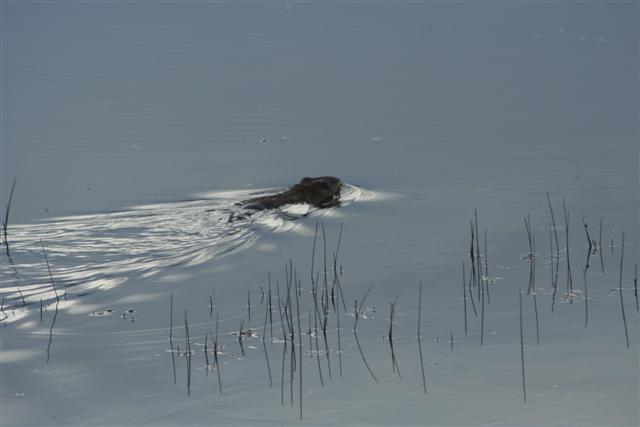
Watch this video on Goldfinch and area
Flour Power
I took an old exersice bike and turned it into a flour grinding machine
Click here to watch a video on the homemade flour grinder
Midway BC and the Railroad War
The Goldfinch Claim
In the late 1800's when Greenwood and Phoenix were just starting Midway was already an established little town. Midway was the location of the District Offices of the Provincial Government (the Mining Recorder, the Court House, the Registrar of Marriages and Deaths, the Court Registrar, the District Coroner and the Chief Constable).
The first mining operations in the Boundary District occurred around 1862. The Kettle River and Boundary Creek were washed for placer gold. The first quartz claim was steaked in 1884 near Boundary Falls. By 1895 there were 370 claims recorded at the Midway Recorder Office. In 1896 some 1279 additional claims were recorded. This was due to the influx of prospectors from Trail Creek and Colville.
In September 1860 Robert Stevenson, a former customs collector at Osoyoos, was gold mining in the Rock Creek area. At the same time American Engineers and British Engineers were surveying the 49 parallel and putting up markers. The British were coming from one direction and the Americans were coming from the other. When they met near Boundary Creek, they were out by over 300 yards. The American line was south of the British line and, as the story goes told by Robert Stevenson, the surveying crew kept going for almost 30 miles before they decided to quit. They assumed that the American line was the wrong one so some Americans built a town close to the British line and called it American Town. It was later discovered that the American line was the right one.
Stevenson also said that he has never read about the goof-up in any newspaper because they didn't want anybody to know about it and others disputed it. But in 1860 a map was drawn by Justice of Peace William Cox supporting Stevenson's report. That is how Boundary Creek got its name.
American Town was situated southwest of the intersection of Dominion St. and Thomet Rd. in Midway. The map also shows English Town which was built to the northeast of American Town. It also shows the creek as "Boundary Creek or Fifteen Mile Creek".
Courtesy of Kootenay Advertiser
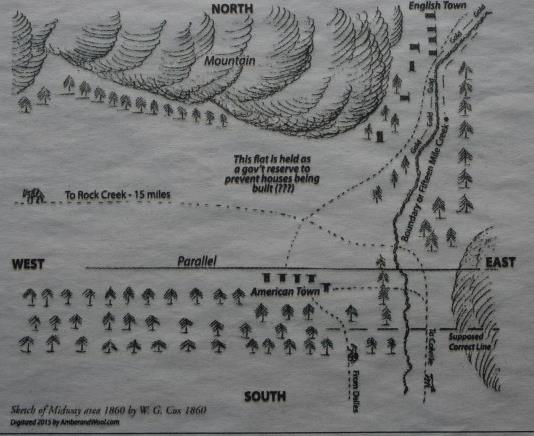
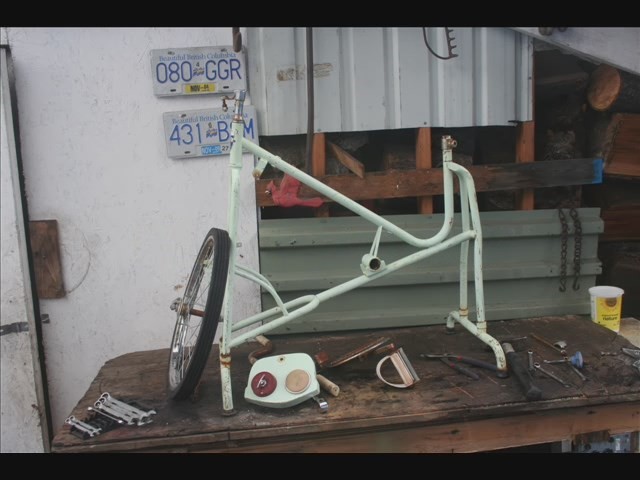
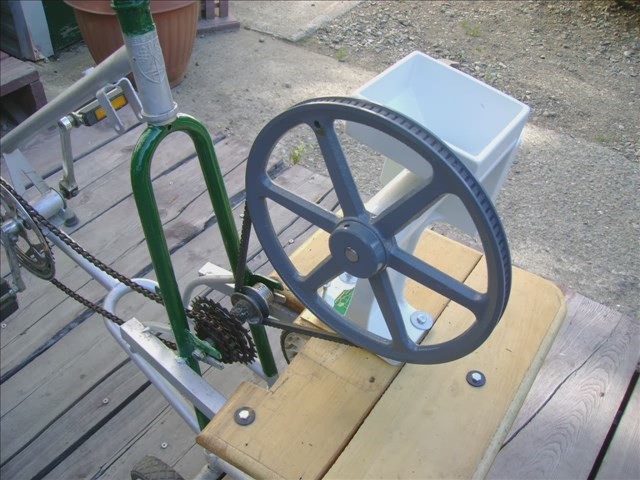
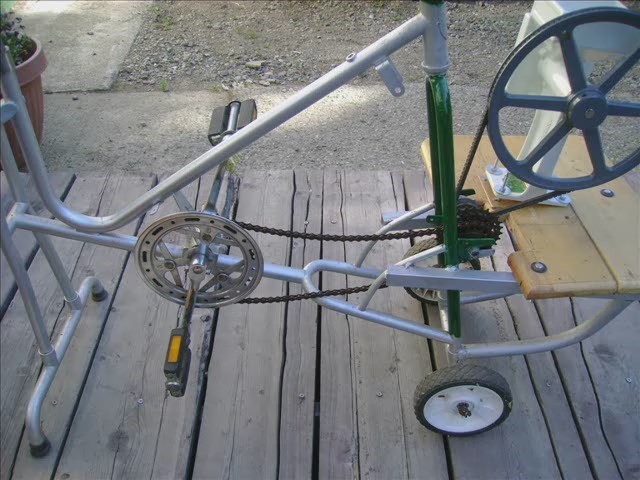
Our Vimeo Channel: The Goldseekers
Our U Tube Chanel: TheGoldseekers





